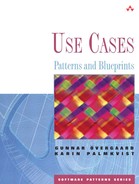This part of the book presents a collection of use-case blueprints of how to model various common usages of systems. We have encountered models of these usages in many different use-case models over the years, and the blueprints in this part of the book are the result of distilling these models into general models of how to express these usages with use cases. The proposed blueprints are not the only ways to model the problems at hand, but they constitute models that we have found useful, understandable, and (last, but not least) correct. All blueprints solving the same modeling problem are grouped into a single chapter where they are presented and discussed.
All chapters in this part are organized in the same way:
Name of modeling problem—. A descriptive name of the problem in a few words
Problem—. A short description of the modeling problem
Characteristics—. States whether the solutions are simple or complex, whether the modeling problem is common or infrequent
Keywords—. A list of keywords characterizing the modeling problem
For each blueprint
Name—. A descriptive name of the blueprint
Model—. A use-case model of the blueprint
Description—. A description of the blueprint model
Applicability—. States when the blueprint should be used
Discussion—. A comprehensive discussion on the modeling problem and the different solutions
Example—. An example of the modeling problem and one or several of its solutions, including use-case descriptions
Analysis model—. A platform-independent class model providing a realization of the use cases in the blueprint use-case models
The chapters containing the use-case blueprints are sorted alphabetically within this part. For each chapter, we list its contained blueprints together with the descriptions of the modeling problems they address.
Chapter 27. Access Control: The system is required to include some kind of access security. Access to the information in the system and to the services of the system is stated by the specific access rights given to the individual user.
Access Control: Embedded Check
Access Control: Dynamic Security Rules
Access Control: Explicit Check
Access Control: Internal Assignment
Access Control: Implicit Details
Chapter 28. Future Task: A task is registered in the system at one point of time, although the actual performance of the task is to take place at some later time.
Future Task: Simple
Future Task: Specialization
Future Task: Extraction
Future Task: Performer Notification
Chapter 29. Item Look-Up: The system is to make it possible for the users to search for items in the system. This look-up procedure can be autonomous, but it can also be used in other use cases.
Item Look-Up: Standalone
Item Look-Up: Result Usage
Item Look-Up: Open Decision
Chapter 30. Legacy System: The system is to include or make use of an already existing system.
Legacy System: Embedded
Legacy System: Separate
Chapter 31. Login and Logout: The users must register or identify themselves before using services offered by the system.
Login and Logout: Standalone
Login and Logout: Action Addition
Login and Logout: Reuse
Login and Logout: Specialization
Login and Logout: Separate
Chapter 32. Message Transfer: A user uses the system to send a message to another user.
Message Transfer: Deferred Delivery
Message Transfer: Immediate Delivery
Message Transfer: Automatic
Chapter 33. Passive External Medium: The system is to monitor or control an external medium that in itself is passive (for example, the surrounding air or a fluid).
Passive External Medium
Chapter 34. Report Generation: The system is to contain a collection of templates for generating different kinds of reports that present information in accordance with the definition given in the templates. The templates also define how a report is to be formatted and similar matters.
Report Generation: Simple
Report Generation: Specialization
Report Generation: Dynamic Templates
Chapter 35. Stream Input: An actor provides a stream of input to the system, and the handling of this input is to be described by use cases. The solution to this problem depends on whether the stream consists of discrete values or of continuous values.
Stream Input: Discrete
Stream Input: Analog
Chapter 36. Translator: The system is to receive an input stream and produce an output stream based on some translation rules.
Translator: Static Definition
Translator: Dynamic Rules
